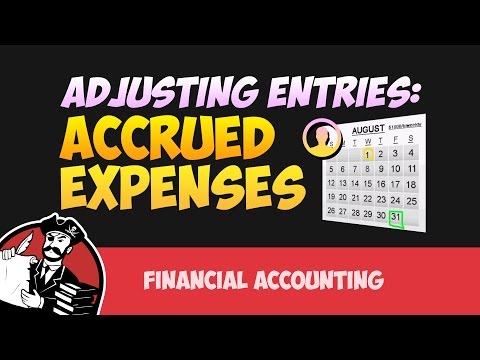4.4: Adjusting for Accrued Items
- Page ID
- 26194
ACCRUALS
This type of adjusting entry will ADD to two accounts. The amount you will be adding was not already on the books. You can have accrued expenses or accrued revenues:
- Accrued Revenues are when a revenue has been earned (we did the work or made a sale) but it has not been recorded in our books. This is common at the end of the year when we are doing work but have not recorded the revenue yet. This would also apply to interest earned on notes receivable even if the interest is not due until the next year.
- Accrued Expenses are when an expense has been incurred but has not been entered into the books. This is common if employees worked during the last week of the year but won’t be paid until the regular payday which is in the next year. The expense needs to be matched with the revenue of the period. Interest expense is another example since it accrues by the day we need to adjust for the expense for the amount of time the note is outstanding during the accounting period.
Let’s look at some examples.
Example 1 – Revenue Goes From Accrued Asset to Accrued Revenue
An asset / revenue adjustment may occur when a company performs a service for a customer but has not yet billed the customer. The accountant records this transaction as an asset in the form of a receivable and as revenue because the company has earned a revenue.
MicroTrain Company did work for a customer on December 31 for $5,000. The customer has not been billed. We would make the following adjusting entry on December 31:
| Debit | Credit | |
| Accounts Receivable | 5,000 | |
| Service Revenue | 5,000 |
Example 2 – Interest Goes From Accrued Asset to Accrued Revenue
For example, assume MicroTrain Company has some money in a savings account. On December 31 the money on deposit has earned one month’s interest of $600, although the company has not received the interest. An entry must show the amount of interest earned by December 31 as well as the amount of the asset, interest receivable (the right to receive this interest). The entry to record the accrual of revenue is:
| Debit | Credit | |
| Interest Receivable | 600 | |
| Interest Revenue | 600 |
Example 3- Salaries go From Accrued Liabilities to Accrued Expenses
Liability/expense adjustments—involves accrued liabilities. Accrued liabilities are liabilities not yet recorded at the end of an accounting period. They represent obligations to make payments not legally due at the balance sheet date, such as employee salaries. At the end of the accounting period, the company recognizes these obligations by preparing an adjusting entry including both a liability and an expense. For this reason, we also call these obligations accrued expenses.
An accountant records unpaid salaries as a liability and an expense because the company has incurred an expense. The recording of the payment of employee salaries usually involves a debit to an expense account and a credit to Cash. Unless a company pays salaries on the last day of the accounting period for a pay period ending on that date, it must make an adjusting entry to record any salaries incurred but not yet paid.
MicroTrain Company paid employees on Friday, December 27. The next payday will be in January of the next year. We need to do an adjusting entry to record the salary earned by employees from December 28 – December 31 of this year. December 28 and 29 are weekend days and employees do not work those days. We need to account for 2 days, December 30 and 31.
If salaries are $900 per week. For a five-day workweek ($900 / 5 days), daily salaries are $180. MicroTrain makes the following adjusting entry on December 31 to accrue salaries for two days ($180 per day x 2 days):
| Dec. | 31 | Salaries Expense | 360 | |
| Salaries Payable | 360 | |||
| To accrue two day’s salaries that were earned but not paid. |
- Accounting Principles: A Business Perspective. Authored by: James Don Edwards, University of Georgia & Roger H. Hermanson, Georgia State University. Provided by: Endeavour International Corporation. Project: The Global Text Project . License: CC BY: Attribution
- Adjusting Entries for Accrued Revenues. Authored by: Note Pirate. Located at: youtu.be/Fn3oUGTf-wk. License: All Rights Reserved. License Terms: Standard YouTube License
- Adjusting Entries for Accrued Expenses. Authored by: Note Pirate. Located at: youtu.be/ONkJXfvrAkc. License: All Rights Reserved. License Terms: Standard YouTube License



